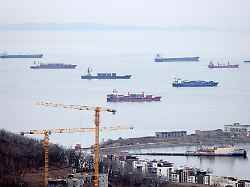Containers from Turkey and China
IfW: Two Russian ports again with more goods
12/06/2022, 4:14 p.m
Despite international sanctions, Russia manages to expand trade with individual countries. According to a study by the Kiel Institute for the World Economy, more containers are arriving at the ports of Novorossiysk and Vladivostok. According to the experts, the sanctions have a stronger effect.
According to a study, more cargo is arriving at Russian ports again despite Western sanctions – mainly due to Chinese and Turkish deliveries. The Black Sea port of Novorossiysk and especially the Pacific port of Vladivostok, which is close to China, showed a significant increase in incoming container loads in November, as the Kiel Institute for the World Economy (IfW) reported in its study. In contrast, hardly any container ships dock in the port of St. Petersburg, which is crucial for trade with Europe. After the Russian invasion of Ukraine on February 24, the West imposed sanctions that have since been tightened several times.
“The sanctions imposed by the EU and other western partners are clearly having an effect and cannot be offset by trade with China or Turkey,” said Vincent Stamer, head of the Kiel Trade Indicator. “Russia’s trade as a whole is around a quarter below the level before the war of aggression against Ukraine, and official trade data have not been reported since the summer.” Russia’s trade remains volatile, according to the information. Starting from low levels, the indicator values showed a plus in exports of 4.8 percent and a minus in imports of 4.4 percent.
According to the IfW, congestion in container shipping decreased significantly in November. According to this, a good eight percent of all goods shipped worldwide are still stuck in traffic. At the end of 2021 it was almost 14 percent. “For the second month in a row, the proportion of containers in traffic jams has fallen rapidly,” it said. “One reason for this is the declining maritime traffic in the North Sea, which reflects weak trade between Germany and the EU.”
For Germany, the indicator for November signals a 3.7 percent drop in exports, while imports are expected to grow by 0.5 percent. “For Germany’s foreign trade, the overall outlook is bleak, although material shortages are easing and German industry continues to benefit from a high order backlog,” said Stamer. “This shows Germany’s difficult situation in a cooling world market.”
